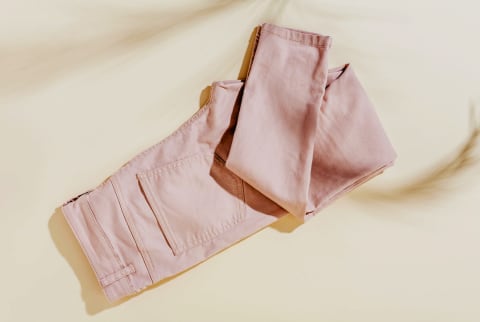Advertisement
Adding This One Thing To Your Laundry Will Make It A Little Easier On The Planet


The U.N. warned us: We have 12 years before the damage we've done to the Earth becomes irreversible. Instead of letting reports like this paralyze us, let's use them to empower us. The experts are saying it's going to take a mix of large-scale change AND individual action to save our planet—and we want to help you do what you can. Consider our new series your no-excuses guide to cleaning up your act, one step at a time. Today, we're sharing a tip that'll really clean up your laundry load.
Just when we all started to get our single-use plastic consumption under control by carrying an arsenal of reusable products and making sustainable changes at home, more research comes out on the pesky and pervasive world of microplastics. Now, avoiding the occasional plastic straw and bottle just isn't enough anymore.
The problem: Microplastics are everywhere.
During the (very, very slow) process of breaking down, plastics and synthetic materials like polyester and silicon turn into microfibers that are super small, less than 5 millimeters across by definition. Microplastics are also added to some products like facial cleansers and cosmetics from the beginning as exfoliants (though there's regulation in place to start phasing this out).
Though these tiny particles are impossible to see with the human eye, they can do some real damage. The jury is still out1 on how exactly microplastics affect our ecosystems, but we do know that pretty much every animal under the sun has them in their bellies—from fish that occupy the deepest ocean trenches to insects flying high in the sky. Just last week, another study that surveyed 50 dead dolphins2, seals, and whales found microplastics in every single one.
"Study after study reveals that marine animals all over the world are ingesting plastics at a disturbing rate," Kate Melges, a Greenpeace USA Plastics Campaigner, said in a statement on the news. "Plastics have been found in the deepest point in the ocean, the Mariana Trench, and in remote waters in the Antarctic. And it's not just marine animals that feel the impacts of plastics; they've been found in our tap water, our food, and even the air we breathe."
Yep, microplastics are part of our food chain too. Last year, microplastics were found in human stool for the first time, which isn't so surprising when you consider that the fish we're eating3 and water we're drinking are filled with the stuff.
Though it's unclear how chronic exposure to microplastic affects our health, it isn't hard to believe that eating chemicals is not doing us any favors. Plus, even if there's no health risk at all, it's still disturbing that these man-made substances are now invading every inch of our world.
The "one small thing" solution: Start by tackling the microplastics in your laundry machine.
While reducing the microplastic load in the environment will take a large-scale shift away from synthetic materials, there are a few ways we can help move things along. One of the easiest places to start is with your laundry, thanks to innovations like the Cora Ball.
Brightly colored and slightly larger than a tennis ball, the Cora Ball is made of recycled plastic that is meant to attract other microplastics. The idea is to throw it in the washing machine to absorb the microfibers that come off your synthetic clothes with each wash. Once you start noticing a buildup of microfibers on the ball (it will kind of look like lint), you throw it in the trash. While sending microfibers off to landfill isn't a perfect solution either, it's better than releasing them directly into our waterways. Cora Ball says it's in the process of finding a way to collect and upcycle the fibers into new material. You can tackle the root of this problem by avoiding synthetic clothes in the first place instead of opting for materials like cotton, hemp, and linen.
One Cora Ball will set you back $29.99, which you can write off as an investment in the planet. It's a micro tweak for a macro problem.
Watch Next
Enjoy some of our favorite clips from classes
Enjoy some of our favorite clips from classes
What Is Meditation?
Mindfulness/Spirituality | Light Watkins
Box Breathing
Mindfulness/Spirituality | Gwen Dittmar
What Breathwork Can Address
Mindfulness/Spirituality | Gwen Dittmar
The 8 Limbs of Yoga - What is Asana?
Yoga | Caley Alyssa
Two Standing Postures to Open Up Tight Hips
Yoga | Caley Alyssa
How Plants Can Optimize Athletic Performance
Nutrition | Rich Roll
What to Eat Before a Workout
Nutrition | Rich Roll
How Ayurveda Helps Us Navigate Modern Life
Nutrition | Sahara Rose
Messages About Love & Relationships
Love & Relationships | Esther Perel
Love Languages
Love & Relationships | Esther Perel











